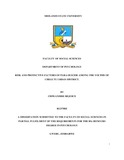Please use this identifier to cite or link to this item:
https://cris.library.msu.ac.zw//handle/11408/2169Full metadata record
| DC Field | Value | Language |
|---|---|---|
| dc.contributor.author | Chiwandire, Rejoice | - |
| dc.date.accessioned | 2017-06-23T08:05:17Z | - |
| dc.date.available | 2017-06-23T08:05:17Z | - |
| dc.date.issued | 2016 | - |
| dc.identifier.uri | http://hdl.handle.net/11408/2169 | - |
| dc.description.abstract | The research was mainly concerned in knowing the risk and protective factors of para-suicide among the youths of Chegutu as well as assessing the extent in which the youth of Chegutu were at risk of para-suicide. The fact that the youths are the ones that are at risk of suicidal behaviours is what drove the researcher to carry out a study to scientifically prove the extent of this truth. In the collection of her data the researcher used a quantitative approach on the bases that the target population was too huge. The descriptive research design guided this research so as to describe and interpret findings. The researcher used a sample of 169 youths from Chegutu Urban educational institutions that is two high schools and one self help college, this was made possible by cluster sampling where by the participants placed her participants in clusters and further on conducted a random sampling. Data was analysed by the SPSS version 21 which is statistical manual which analyses data numerically, cross tabulation tables were run analysing para-suicide which in this research was the depended variable against other risk and protective factors which were in-depended variables. The main findings in this research was that indeed the youths of Chegutu Urban are at risk of para-suicide as the those who had low risks were 24.4%, those with moderate risk were 11.2% and those with a high risk were 1.2% however it should be noted that in the study 63.3% of the youths were are not at risk of para-suicide. The research also brought to light that there were risk factors of para-suicide and these were hopelessness, depression, family factors, alcohol and substance use as well as stressful life events. Protective factors were also known and they were hopefulness, family factors, refraining and low use of substances, social support from peers and significant others and religious beliefs. This led to the conclusion that further research is needed to be done in Zimbabwe as a whole on the issue of para-suicide, its risk and protective factors. In Chegutu, the community as whole must work hand in hand so as to protect the youths from para-suicide by making use of the protective factors and the recommendations mentioned in this study. | en_US |
| dc.language.iso | en | en_US |
| dc.publisher | Midlands State University | en_US |
| dc.subject | Para-suicide | en_US |
| dc.subject | Youths | en_US |
| dc.title | Risk and protective factors of para-suicide among the youths of Chegutu urban district | en_US |
| item.fulltext | With Fulltext | - |
| item.languageiso639-1 | en | - |
| item.grantfulltext | open | - |
| Appears in Collections: | Bsc Psychology Honours Degree | |
Files in This Item:
| File | Description | Size | Format | |
|---|---|---|---|---|
| REJOICE PARASUICIDE.pdf | Full text | 1.73 MB | Adobe PDF |  View/Open |
Page view(s)
122
checked on Oct 9, 2025
Download(s)
62
checked on Oct 9, 2025
Google ScholarTM
Check
Items in MSUIR are protected by copyright, with all rights reserved, unless otherwise indicated.



